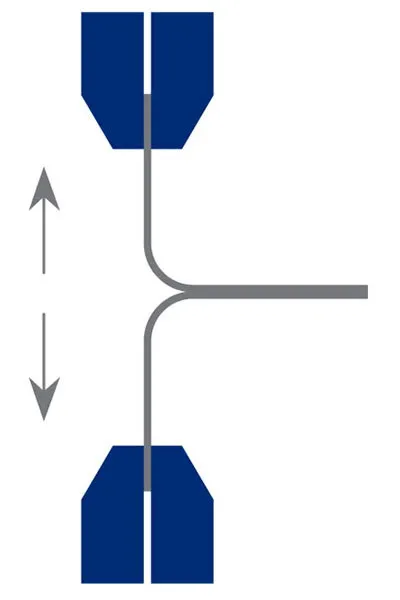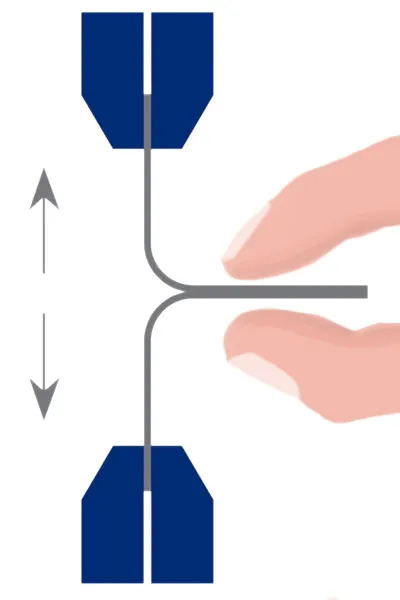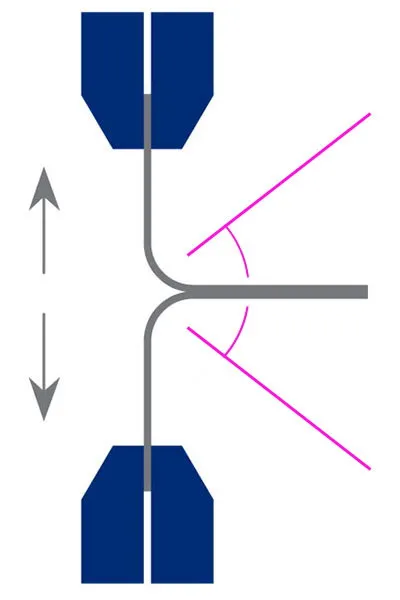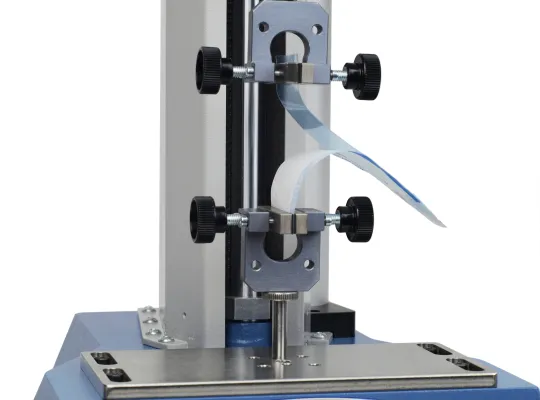Search results
Standards
Featured or equivalent test standards for Mecmesin solutions in this section
Term Video
Test summary
Specimens are cut to a specified width. The seal is then peeled apart by holding the two “legs” of the barrier material in the jaws of a force testing stand set to separate at a constant speed between 200 - 300 mm/min. while the force and displacement are continuously measured. The peak force required to separate the seal is reported, this can also be expressed as peak force per width of the seal material in N/m. Depending upon the characteristics of the specimen, it may also be informative to report the average peeling force over the width of the seal as it separates, discarding the first 10% and the last 10% of the force Vs displacement curve.
Test apparatus
Tensile tester with grips and suitable range loadcell. This may be a vertical testing stand, or alternatively a horizontally oriented instrument
Preparation
Cut a sufficient quantity of strips from a representative sample to a width of 15 mm, 25 mm or 25.4 mm perpendicular to the seal, and 75mm plus the width of the seal in length. If required, condition the specimens in accordance with ASTM E 171
Test method
1. If required, condition the samples as per ASTM E 171.
2. Cut strips from the sample to the dimensions defined in the standard.
3. Clamp the ends of the sample strip into the jaws of the tensile tester with the seal perpendicular to the direction of movement, and equidistant between the fixed and moving jaws.
4. If required, support the tail of the test specimen (see the standard for an explanation).
5. Set the tensile tester in motion at a speed between 200 and 300 mm/min.
6. Record the tensile force and displacement as the seal is peeled apart.
Report
Record all details necessary to identify the sample including width and machine direction in relation to the direction of pull.
Report the speed of separation used by the tensile tester, and the method used to support the tail of the sample if appropriate.
Report the maximum tensile force in newtons encountered as the specimen is stressed to failure. This can also be expressed as force per unit width of the seal in newtons per metre.
Note the method of failure of the seal.
Depending upon the characteristics of the force Vs displacement curve, it may be informative to calculate the average force as the seal is separated, discarding the first and final 10% of the force Vs displacement curve.




El MultiTest 1-i se ha comprado para probar las propiedades físicas de las materias primas y los productos terminados. La celda de carga 10N puede medir hasta dos decimales, lo que proporciona una lectura muy sensible y precisa, y esta prueba funciona muy bien. El MultiTest 1-i satisface nuestras necesidades y con el tiempo ha demostrado ser fácil de usar.
Adriana Jamesova,
Sales Healthcare

Para cumplir con el estándar británico con respecto a las resistencias de sellado térmico en las bolsas médicas, Mecmesin proporcionó un sistema amigable para el operador, que muestra los datos en formato gráfico para mostrar claramente el cumplimiento del estándar.
David Dixon, técnico de garantía de calidad
Rocket Medical Plc


Hablar con un experto
¿Tienes alguna pregunta sobre un producto? Solicite una llamada de uno de nuestros ingenieros técnicos de ventas ahora.







